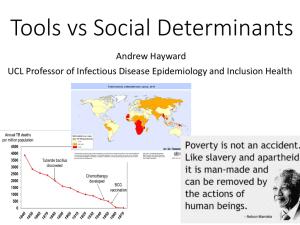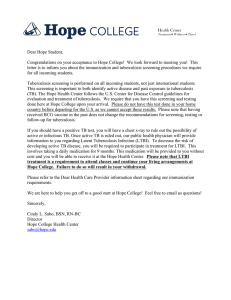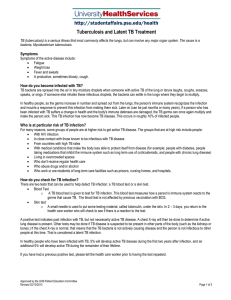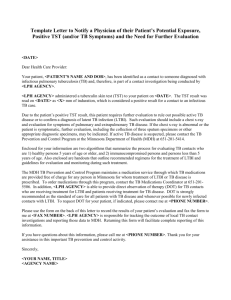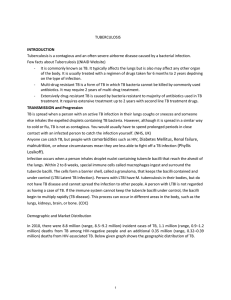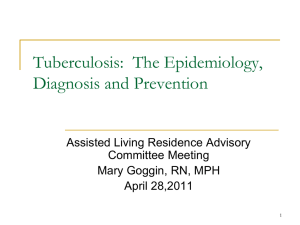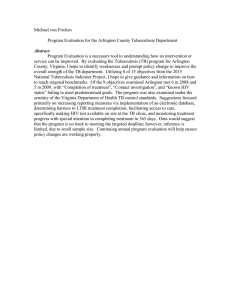Population Screening and Treatment of Margarita Elsa Villarino MD MPH
advertisement
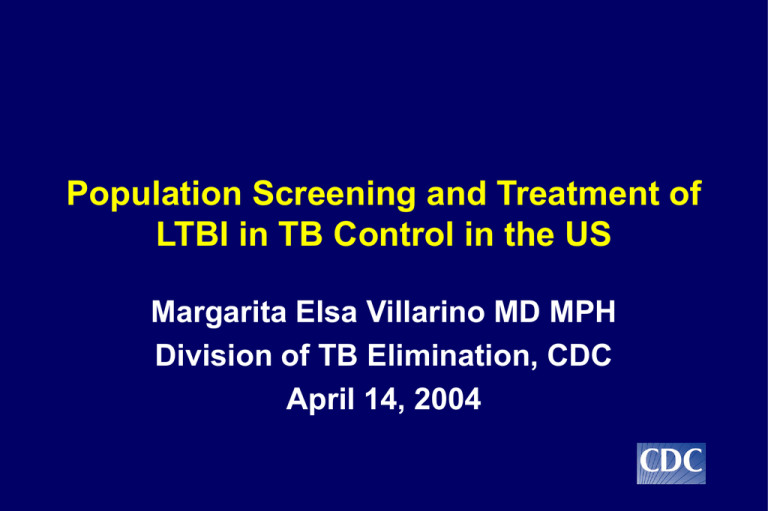
Population Screening and Treatment of LTBI in TB Control in the US Margarita Elsa Villarino MD MPH Division of TB Elimination, CDC April 14, 2004 TB Prevention and Control in the United States • The fundamental strategies include: – Early detection and treatment of patients who have active TB disease – Therapy for persons with latent TB infection to prevent the development of TB – Prevention of institutional transmission of M. tb – BCG vaccination is not recommended as a routine strategy For Tuberculosis Cure = Prevention Therapy for Latent Tuberculosis Infection • Rationale – Reduce individual risk for developing active disease – Shrink pool of infected persons at risk for tuberculosis Compartment Model of TB Epidemiology (The TB-Naïve Hosts) Population M. tuberculosis Exposed Population LTBI Exposed Population TB LTBI Exposed Population TB Contagious TB LTBI Exposed Population International strategy: TB Contagious TB Detect Treat Disinfect Separate LTBI Exposed Population BCG (not in U.S.) U.S. strategy: Treat LTBI TB LTBI Exposed Population Targeted Tuberculin Testing and Treatment of Latent TB Infection, MMWR 2000;49(No.6) Newest Terminology • Latent tuberculosis infection (LTBI) • Treatment of LTBI (TLTBI) • Targeted testing (TTTLTBI) • “Decision to test is a decision to treat.” Conditions that are counted under Medical Risk HIV infection Tuberculin skin test conversion Fibrotic lesions (on chest X-ray) consistent with old, healed TB Injection drug use Diabetes mellitus Prolonged high-dose corticosteroid therapy or other intensive immunosuppressive therapy Chronic renal failure Some hematologic disorders, such as leukemia or lymphoma Specific malignant neoplasms, such as carcinoma of the head or neck Weight at least 10% less than ideal body weight Pulmonary silicosis Gastrectomy, or jejunoileal bypass Age 5 years Recent exposure to TB Circumstances that are counted under Pop. (population) Risk Residency or occupation in high-risk congregate settings: Prisons and jails Health care facilities Nursing homes and long-term facilities for the elderly Shelters for homeless persons Birth in a country having a high prevalence or incidence of TB: Includes Immigrants Refugees Students Some migrant workers Socioeconomic predictors of exposure: Low income Inner-city residence Migrant labor Reported TB Cases per 100,000 Population United States, 1953 – 2000 Log incidence rate 100 * 1968: First ATS Guidelines for “Universal” TST and PT * 10 1 1953 *Change in case definition Year 1985 2000 Factors Affecting the Impact of TTTLTBI • Tuberculin skin testing: the diagnosis • Prediction of progression to disease • Completion of therapy and programmatic costs • Efficacy of treatment • Safety of treatment TB Prevention Effectiveness Targeted Testing Efficacy Efficiency Completion of therapy Risk of progression The Tuberculin Skin Test (TST) • Some 2-12 wks after infection with M. tb, there is a delayed-type hypersensitivity (DTH) reaction at the site of tuberculin injection • DTH reactions begin 5-6 hrs after injection and reach a maximum at 48-72 hrs • Since the 1930s, TST has been used to screen persons or populations for LTBI Robert Koch (1843 -1910) Reading the Tuberculin Skin Test • Read reaction 48-72 hours after injection • Measure only induration • Record reaction in millimeters Prevalence rate of LTBI • Yield of testing • – higher rate gives higher yield Predictive value of a positive result – higher rate gives better predictive value Positive Predictive Value of a Tuberculin Test Am J Respir Crit Care Med; 2000, Vol 161, p 1389 Positive Predictive Value Prev of TB Infection (%) 90 Specificity of 0.95 Specificity of 0.99 0.99 0.999 50 25 10 5 1 0.95 0.86 0.67 0.50 0.16 0.99 0.97 0.91 0.83 0.49 0.1 0.01 0.03 0.002 0.10 0.09 Classifying the Tuberculin Reaction $5 mm is classified as positive in • HIV-positive persons • Recent contacts of TB case • Persons with fibrotic changes on chest radiograph consistent with old healed TB • Patients with organ transplants and other immunosuppressed patients $10 mm is classified as positive in • Recent arrivals from high-prevalence countries • Injection drug users • Residents and employees of high-risk congregate settings • Mycobacteriology laboratory personnel • Persons with clinical conditions that place them at high risk • Children <4 years of age, or children and adolescents exposed to adults in high-risk categories $15 mm is classified as positive in • Persons with no known risk factors for TB Skin Test Reactions to Mycobacterium tuberculosis Purified Protein Derivative and Mycobacterium avium Sensitin Among Health Care Workers and Medical Students in the United States “Infections with NTM are responsible for the majority of 5-14 mm PPD reactions among US-born health care workers...” von Reyn CF, Horsburgh CR, Olivier KN. International Journal of Tuberculosis & Lung Disease. 2001;5:1122-1128. Tuberculosis Screening in Private Physicians' Offices, Pennsylvania, 1996 “Only 8/59 (14%) physicians followed published guidelines for placement and reading of tuberculin tests.” Schulte JM, Moore M, Kistler V, Margraf P, Christman R, Valway SE, Onorato IM, Stader B. American Journal of Preventive Medicine 1999;16:178-181. QuantiFERON®-TB (QFT) whole-blood IFN release assay for the detection of M. tuberculosis infection QFT vs. • in vitro • multiple antigen mixes • no boosting • 1 patient visit • minimal inter-reader • • variability results in 1 day stimulate w/i 12 hrs TST • in vivo • single antigen mix • • • • • (PPD) boosting 2 patient visits inter-reader variability results in 2 - 3 days read in 48 - 72 hrs Learning Objective (QuantiFERON) Name prospective new blood tests that could detect latent infection as well as a skin test can? QuantiFERON®-TB (QFT) is approved for specific indications. Research is underway for robust tests with broader applications. Factors Affecting the Impact TTTLTBI • Tuberculin skin testing • Prediction of progression to disease • Completion of therapy and programmatic costs • Efficacy of treatment • Safety of treatment TB Prevention Effectiveness Prevalence rate of LTBI Efficacy Efficiency Completion of therapy Risk of progression TB LTBI Exposed Population Risk of Progression to TB • Markers for risk: – recent infection •contacts •converters – underlying medical conditions: HIV infection Risk of TB Disease by Time of M. tb Infection • Among 1,472 persons enrolled in the placebo arm of 2 trials of the efficacy of LTBI (Ferebee SH. Adv Tuberc Res. 1970) – 19 developed TB in 1st yr of follow-up (FU) – 7 developed TB in subsequent 7 yrs of FU – Difference in case rate 12.9 vs 1.6 per 1,000 person-yrs • Among 2,550 British children enrolled in the unvaccinated arm of TB vaccine study (Sutherland I. TSRU Prog Rep. 1978) – 121 (5%) developed TB in 15 yrs of FU – Of these, 54% cases during 1st yr, 82% within 2 yrs Proportion of Persons with TB Infection and Disease Co-infected with HIV 100% 100% 50% HIV+ 10% HIV+ TB Infection TB Disease Circumstances that are counted under Pop. (population) Risk Residency or occupation in high-risk congregate settings: Prisons and jails Health care facilities Nursing homes and long-term facilities for the elderly Shelters for homeless persons Birth in a country having a high prevalence or incidence of TB: Includes Immigrants Refugees Students Some migrant workers Socioeconomic predictors of exposure: Low income Inner-city residence Migrant labor Factors Affecting the Impact of TTTLTBI • Tuberculin skin testing • Prediction of progression to disease • Completion of therapy and programmatic costs • Efficacy of treatment • Safety of treatment TB Prevention Effectiveness Prevalence rate of LTBI Efficacy Efficiency Completion of therapy Risk of progression Issues Associated With Completion of TLTBI • Programs and systems • Duration of regimen Acceptability of Short-Course Rifampin and Pyrazinamide Treatment of Latent Tuberculosis Infection Among Jail Inmates >21,000 admissions (1 yr.) 75% of inmates tested 68% of tests read 260-fold drop 07.3% reactor rate 12.3% start rate 48% completion rate (81 inmates; 2-mo regimen) Bock N N, Rogers T, Tapia J R, Herron, G D, DeVoe, B, Geiter, L J. Chest 2001;119:833-837. A Tuberculin Screening and Isoniazid Preventive Therapy Program in an Innercity Population 7,246 participants, various community settings 4,701 (65%) tests read 809 (17%) reactors 86-fold drop 409 eligible for treatment 84 completed treatment Bock NN, Metzger BS, Tapia JR, Blumberg HM. American Journal of Respiratory & Critical Care Medicine. 1999;159:295-300. Optimal Duration of INH Therapy for the TLTBI, MMWR 2000;49(No.6) • The duration of INH therapy should be >6 months to provide maximum protection. • Therapy for 9 months appears to be sufficient, with little or no value of longer treatment. Effect of the Duration of INH Therapy on the Prevention of Active TB TB Case Rates Reduction in TB Placebo INH (10 yr. follow-up) Patients taking >80% of medication for: 10-12 mo 24.9 7.9 68.3 0 - 9 mo 18.6 15.6 16.1 Patients taking medication >10 months compliant for: 60%-79% 40%-59% 26.2 19.0 11.2 9.1 Ferebee, SH. Adv Tub Res 1970;17:28-106 57.3 52.1 How Much Isoniazid Is Needed for the Prevention of Tuberculosis? Comstock GW, Int J Tuberc Lung Dis 1999;3:847-50 • • Longer duration of therapy corresponded to lower TB rates among those who took 0-9 mo No extra increase in protection among those who took >9 mo Percentage of Infected Contacts Age 15 - 34 Completing Treatment for LTBI 100 National Objective = 75% Percent 80 60 67 68 61 62 63 64 64 65 62 63 64 68 40 20 0 1987 1988 1989 1990 1991 1992 1993 1994 1995 1996 1997 1998 Year TB Prevention Effectiveness Prevalence rate of LTBI Efficacy Efficiency Completion of therapy Risk of progression Use of Isoniazid for the Prevention of TB Among Patients Not Known to Be Infected with HIV Trial -- regimen Population Years of % Observation Reduction USPHS -- 12-mo INH Pediatrics clinics primary tuberculosis 10 88 Health departments contacts 4-10 57 Mental institutions hospital/school 10 62 Alaskan villagers community 6 59 Health departments inactive lesions 5 60 TB Rate (Cases/100 PYO) Isoniazid Preventive Therapy HIV Infection - TST Positive 14 12 83% Protective Efficacy 67% 70% 40% 10 8 Treatment Placebo 6 4 2 0 Haiti (12H) Uganda (6H) Zambia (6H2) Kenya (6H) Short-Course Regimens HIV Infection - TST Positive TB Rate (Cases/100 PYO) 5 Rifampin-Containing Isoniazid 4 3 2 1 0 Haiti (2RZ) International Uganda Consortium (3RH) (2RZ) Uganda (3RHZ) Zambia (3RZ) Problems Associated with TLTBI • Low adherence with INH therapy, mostly associated with long duration • Potential better adherence with shorter (2RZ) regs • Effectiveness of 2RZ has not been studied in – HIV-seronegative persons (decreased tolerability?) – children • High pill burden, drug toxicity, drug interactions with 2RZ • DOT necessary for intermittent regimens USPHS Study 26: Highly intermittent short-course treatment of LTBI • Patients with LTBI at high risk for developing active disease will receive INH for 9 months OR once weekly INH/rifapentine for 12 doses (3INH/RPT) • Main study outcome: rate of development of active tuberculosis • Almost ~3,000 enrolled to date, sample size = 8,000 total or 4,000 per arm Factors Affecting the Impact of TTTLTBI • Tuberculin skin testing • Prediction of progression to disease • Completion of therapy and programmatic costs • Efficacy of treatment • Safety of treatment Toxicity of Isoniazid in Persons Without HIV Infection • Hepatitis 10.3/1000 persons • Death due to hepatitis 0.6/1000 persons • Age-related hepatotoxicity 35 years 0.6-1.3/100 persons > 35 years 2.0-3.1/100 persons • Risk factors Active liver disease, Alcohol • Mortality risk associated with pregnancy, Hispanic ethnicity Reports of Severe Liver Injury Associated with RZ Treatment of LTBI October 2000 – May 23, 2002 • 40 *cases (17 jurisdictions) • – 32 hospitalized – 8 fatal – 33 investigated 96 other reports of liver injury * A case is defined as a person who was hospitalized or died due to liver injury associated with RZ. International strategy: TB Contagious TB Detect Treat Disinfect Separate LTBI Exposed Population BCG (not in U.S.) Essential TB Infection Control Activities • Screening. • • Measures to identify persons with active TB disease or LTBI Containment. Measures used to prevent transmission Assessment. Collection and analysis of data to monitor whether the S&C activities are being implemented Vaccination Against Tuberculosis Recommendations for BCG Vaccination • Not recommended in immunization programs or TB control programs in the U.S. • BCG vaccination undertaken after consultation with health department •Infant or child with negative skin test and continuous exposure •HCW in areas of high MDRTB and deficient TB infection control precautions Contraindicated for persons with impaired immunity • BCG Vaccination and Tuberculin Skin Testing • Tuberculin skin testing not contraindicated for BCG-vaccinated persons • LTBI diagnosis and treatment for LTBI considered for any BCGvaccinated person whose TST is positive, if any of these circumstances are present: - Was contact of another person with infectious TB - Was born or has resided in a high TB prevalence country - Is continually exposed to populations where TB prevalence is high TB Control in the US Population/ Exposure Risks Medical Risks Prevention opportunities For Tuberculosis Cure = Prevention
